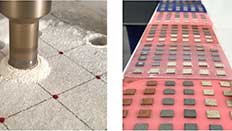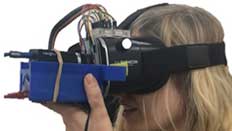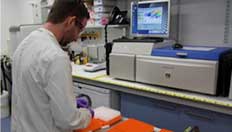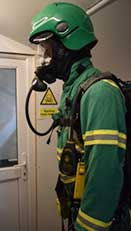Toxicology
Overview
The human body is constantly exposed to a wide variety of chemicals which have the potential to cause adverse health effects.
Such materials may be naturally occurring or anthropogenic and exposure may be accidental or intentional.
The human body has a remarkable ability to deal with harmful chemicals and has evolved a range of strategies to detoxify and eliminate these materials.
Understanding such mechanisms at the molecular, cellular and organism level is important so that we can mitigate the effects of exposure.
Therefore, the work of the Toxicology Group is primarily concerned with how toxic chemicals may interact with humans in terms of dermal and respiratory exposure and to develop means of preventing adverse health effects through reducing absorption and developing appropriate diagnostic instruments, medical treatments and detection technologies.
The Group is part of the Research Centre for Topical Drug Delivery and Toxicology.
What the group does
 We currently have a diverse range of on-going research, which uses a variety of methodologies ranging from molecular and cellular techniques through to non-invasive biophysical instrumentation for human volunteer studies, all supported by an extensive and state-of-the-art analytical capability.
We currently have a diverse range of on-going research, which uses a variety of methodologies ranging from molecular and cellular techniques through to non-invasive biophysical instrumentation for human volunteer studies, all supported by an extensive and state-of-the-art analytical capability.
The main areas of current research include development of new in vitro models for assessing the toxicity of nanoparticles, the potential of dermal biomarkers for diagnostic or prognostic applications, the development and characterisation of whole body decontamination systems and clinical studies on the effectiveness of topical products.
We also provide technical support and advice to UK and international government departments as part of the Group's acknowledged expertise in areas relating to civilian defence and performance testing of chemical detectors.
In summary, our activities currently include:
- Cellular metabolism and toxicology
- In vitro dermal absorption
- Decontamination
- Chemical detection
- Medical countermeasures
- Biodosimetry and forensics
- Clinical research trials (topical formulations)
- Chemical incident response support
Key research projects
Studies of mass casualty decontamination and revised incident response procedures
 The toxicology research group has made a significant, international contribution to the develop of emergency response procedures for managing casualties resulting from the accidental or deliberate release of toxic materials. This includes contributions to the UK’s new Initial Operational Response (IOR) and the lead role in developing new federal (USA) guidance; PRISM. In addition to the planning, performance and reporting of large-scale exercises, our research team has a globally unique facility, which includes the large-scale evaluation of building decontamination systems (performed in collaboration with the Zurich University of Applied Sciences), as well as bespoke laboratory apparatus (including a unique diffusion cell system) and clinical studies to support investigations of personal and mass casualty decontamination procedures.
The toxicology research group has made a significant, international contribution to the develop of emergency response procedures for managing casualties resulting from the accidental or deliberate release of toxic materials. This includes contributions to the UK’s new Initial Operational Response (IOR) and the lead role in developing new federal (USA) guidance; PRISM. In addition to the planning, performance and reporting of large-scale exercises, our research team has a globally unique facility, which includes the large-scale evaluation of building decontamination systems (performed in collaboration with the Zurich University of Applied Sciences), as well as bespoke laboratory apparatus (including a unique diffusion cell system) and clinical studies to support investigations of personal and mass casualty decontamination procedures.
Sebomics: Sebum as a biomonitoring matrix
The objectives of this internally-funded project are to establish the normal mixture of chemicals present on the skin surface and to subsequently identify the presence of individual chemicals which may be indicative of disease states or exposure to environmental pollutants. Recent work has demonstrated the potential of sebomics to detect biomarkers of diabetes, with plans to extend this work for the pre-clinical detection of other chronic illnesses such as Parkinson’s Disease, Alzheimer’s and certain types of cancer. Early diagnosis of such diseases is fundamental to the success of established treatments.
Pupillometry for the pre-clinical detection of diseases and chemical exposures
 We have successfully developed a prototype instrument for detecting subtle changes associated with the innervation and/or retinal function of the eyes. The prototype device is sensitive in detecting exposure to substances which produce an inhibitory effect on the central nervous system and future studies will determine the predictive accuracy of the instrument for detecting early (pre-clinical) signs of chronic diseases and infections.
We have successfully developed a prototype instrument for detecting subtle changes associated with the innervation and/or retinal function of the eyes. The prototype device is sensitive in detecting exposure to substances which produce an inhibitory effect on the central nervous system and future studies will determine the predictive accuracy of the instrument for detecting early (pre-clinical) signs of chronic diseases and infections.
Optimisation of chemical detector technologies
We are currently developing new technologies to enhance the sensitivity of standard platform technologies for the detection and monitoring of chemicals on surfaces, in mixed solutions and in air samples.
Development of a human model of incontinence-associated dermatitis
This project included the development of a new human volunteer model for the provocation of skin lesions following exposure to synthetic urine and has improved our understanding of how dermatitis develops in immobile patients. The main outcome of the project was a demonstration of the efficacy of a novel topical skin protectant for the prevention and treatment of IAD.
Design, manufacture and validation of a novel dermal absorption measurement system for assessing exposure to nanoparticles
 Current methods for assessing skin exposure to chemicals are based on a long-established system which uses immobile samples of skin tissue. The recent emergence of nanotechnologies has focused attention on developing more relevant models for identifying materials which may penetrate the skin via mechanisms other than passive diffusion. Our work has successfully developed and validated a new dermal absorption system (CutaFlex™) which can simultaneously flex skin and monitor percutaneous absorption to more accurately reproduce realistic exposure scenarios.
Current methods for assessing skin exposure to chemicals are based on a long-established system which uses immobile samples of skin tissue. The recent emergence of nanotechnologies has focused attention on developing more relevant models for identifying materials which may penetrate the skin via mechanisms other than passive diffusion. Our work has successfully developed and validated a new dermal absorption system (CutaFlex™) which can simultaneously flex skin and monitor percutaneous absorption to more accurately reproduce realistic exposure scenarios.
Animal alternatives for the prediction of toxicity
The identification of appropriate toxicity tests to replace animals is a major priority and so we are currently developing a non-mammalian model which can provide information on the inherent toxicity of a substance in addition to simultaneously identifying its mechanism(s) of action.
Other services
Chemical analysis
We provide bespoke analytical services for the pharmaceutical industry and have established a service for the identification of unknown substances in forensic samples and prohibited substances in dietary supplements. Our analytical work is performed under a quality management system for which we are actively seeking accreditation (ISO17025).
Clinical studies
We also offer clinical studies (which can be performed to GCP) for the evaluation of topical formulations and personal protective equipment. This work is supported by an extensive range of non-invasive biophysical instruments for investigating skin barrier function, optical/spectral skin properties, surface topology, lipid oxidation and hydration.
Testing and evaluation of explosives and chemical detectors
 Test systems for small and large-scale performance evaluation of detectors are available in-house. Our test systems include a flow-through chamber which produces precise concentrations of gases and vapours which can be validated against the “gold standard” technique of thermal desorption gas chromatography mass spectrometry (TD-GC-MS).
Test systems for small and large-scale performance evaluation of detectors are available in-house. Our test systems include a flow-through chamber which produces precise concentrations of gases and vapours which can be validated against the “gold standard” technique of thermal desorption gas chromatography mass spectrometry (TD-GC-MS).
We are also able to assess the sensitivity and response range of explosives detectors and radiation monitors.
Find out more
For further details or enquiries, Professor Rob Chilcott can be contacted by email, at r.chilcott@herts.ac.uk
Find out about how we can support your organisation on research and development projects.